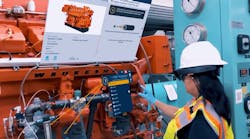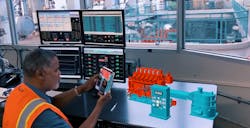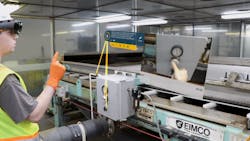Leveraging Augmented Work Instruction in Wastewater Facilities
Keeping wastewater equipment up and running is more than an economic priority. Wastewater management is downright critical for serving customers and protecting the environment. Ensuring pumps, filtration systems, equipment for evaporation and distillation, reverse osmosis systems, and testing devices continue to run properly protects people and the environment.
The safe and efficient operation of wastewater facilities depends upon an expertly trained staff capable of diagnosing, maintaining, and repairing specialized systems and complex equipment when necessary to ensure they work flawlessly. It is a mighty task, and one that requires efficient sharing of knowledge and expertise across teams and generations.
Better Training
The training of frontline wastewater workers is a necessary, albeit costly and time consuming investment. However, even with superb training, there is simply no replacement for operational experience. Wastewater staff with hands-on experience possess a level of knowledge unobtainable in a classroom or from a training program. Facilities need to find ways to distribute this invaluable knowledge more broadly throughout the organization and to less experienced workers. This information also needs to be available at all times, even the graveyard shift.
Municipalities and wastewater facilities must also continuously upskill frontline veterans on new equipment and new competencies. Additional skillsets are frequently at technology’s cutting-edge and the need to provide ongoing and regular training to even the most experienced operator has become more essential than ever.
Technology, including augmented reality (AR), offers ways to both tap into the knowledge and expertise of experienced workers, and train the next generation of operators on core procedures and new protocols. Capturing and putting in-house knowledge to work enables treatment facilities to enhance performance and keep operations running continuously and smoothly.
For example, plant operators can follow step-by-step work instructions from videos, photos, audio and other on-demand references pertinent to the task or step at hand. These operators can perform the complex tasks described in these instructions while looking at actual equipment. With guidance provided via their headset or mobile device, operators can more accurately follow the instructions and complete the task correctly the first time.
Improving inspection training through augmented work instructions provides immediate benefits. Inspections generate valuable data that advanced AR-enabled platforms like Manifest from Taqtile capture for analysis in reports, and archive for compliance or future review. Advanced AR-enabled platforms also provide built-in fault reporting, capturing of completion evidence, and creation of detailed work logs. These fault reports can also integrate with other facility applications to initiate review and resolution processes for compliance and continuous improvement efforts.
Capture & Share Organizational Knowledge
Within wastewater facilities, the collection and digitization of unique information such as equipment-specific maintenance and repair procedures, system insights, emergency procedures and protocols can greatly increase uptime, operational efficiencies, and the capabilities of staff regardless of experience.
The ability for facility experts to intuitively create specific work-instructions and digitized procedures within an AR-enabled platform is essential, especially when it comes to communicating procedures for regularly performed tasks and procedures that are only infrequently required. Optimal work-instruction platforms make it possible for knowledge experts to create step-by-step digital work instructions overlaid on equipment, without additional programming services or consulting fees.
Experienced technicians can document their knowledge, providing additional context and guidance to less experienced workers new to a procedure or machine. These insights can be made available in addition to supporting materials assisting in the repair or maintenance process, such as supplemental photographs, videos, PDFs, or manuals and documents, all delivered in a hands-free, heads-up display when needed.
One powerful aspect of augmented work instruction systems is the use of digital twins. Digital twins provide access to clear, uncomplicated views of the equipment and its individual components, and some AR-enabled platforms can display IoT/sensor data as well. This virtual view makes it easier to follow repair and maintenance procedures on-site, perform training in a classroom, and review equipment remotely. The virtual, 3D representations, also provide different perspectives inside the equipment itself, enabling operators to see the state of the equipment and understand how individual pieces of machinery are constructed.
Immediate Support
Real-time access to content ranging from step-by-step video instructions walking frontline staff through complex procedures, to detailed holograms, will dramatically improve staff confidence and performance.
But there will certainly be occasions when unique knowledge, or infrequently used procedures are required. When these occasions arise, an expert is needed ASAP. Real-time interactions between remote experts and deskless operators have traditionally been limited to simple audio communication. AR can change that by sharing the complete experience of the on-site operator with the remote expert through real-time augmented communication on most any popular AR-enabled device or even an iPad.
The ability to enable two-way video, real-time remote guidance, and on-site access to repositories of knowledge will remove ambiguity from the communication process and empower wastewater workers to safely, efficiently, and thoroughly complete complex tasks right at the machine.
By empowering remote experts to provide precise direction to frontline staff with real-time access to the operator’s user interface through a shared environment like the Manifest platform, critical repair and maintenance tasks can be completed more efficiently and more accurately the first time.
For example, an expert working from a tablet in a remote location can follow the operator through a first-person viewpoint, seeing precisely where they are looking with tracked eye movements. By tracking the operator’s view, a remote expert can guide the operator with highly accurate, real-time instruction, including annotating within the operator’s environment, using directional arrows or highlights as guides.
Technical Considerations
Select work-instruction platforms that are device agnostic. This provides choice to facility managers and municipalities. Head-mounted displays (HMDs), wearable computers, smartglasses, and mobile devices, such as an iPad, can all be viable options for delivering AR-enhanced work instruction. With the ability to leverage a range of devices, frontline workers can be outfitted with the optimal tool to get the job done.
Consider implementing 5G to extend the value and usability of AR applications, making them faster, more secure, and even more resilient across an entire plant’s interior and exterior locations. The sprawling footprints of wastewater operations are tailor made for 5G. Because 5G reduces latency and increases throughput, staff can better monitor the status of machines where milliseconds matter to prevent accidents that can damage equipment, injure workers, and harm the environment.
Staff knowledge can be supplemented by data, such as data collected from rapidly expanding SCADA, Industrial Internet of Things (IIoT), and other systems, provided by a new generation of equipment sensors. These data-producing sensors are not just standard on new equipment but can also be incorporated into legacy equipment. This combination of human-based skills and experience, guided by real-time, machine-level data, empowers frontline workers at wastewater facilities to keep complex systems running smoothly.
Seattle Puts AR to Use
King County’s Wastewater Treatment Division and Department of Natural Resources and Parks, serving the greater Seattle area, recently leveraged AR-enabled work instruction technologies to overhaul its training regimen for new employees.
The West Point Treatment Plant is one of the largest treatment plants west of the Mississippi. On average, 54 million gallons of wastewater go through the plant every day (mgd), rising to 440 mgd during the rainy season. King County selected the Manifest AR platform from Taqtile to capture the skills and knowledge of long-time staff members, enabling them to author augmented work instructions over the facility’s actual equipment.
The Wastewater Treatment Division’s work-instruction library of content includes job templates and supplemental materials in the form of videos, photographs, bookmarked documents like material safety data sheets and equipment schematics, and annotations. Facility operators access these job instructions hands-free, using them to learn procedures on a digital twin, and to complete machine maintenance checklists in the plant as they work.
“I’m totally excited about the future. I think what this is helping us do is change the culture at King County. And it can really have a huge impact on our ability to deliver services to customers more effectively,” said John Klein, King County strategic technology planning director.
Remote assistance, remote support, and team collaboration are available to members of the King County staff on any job step using the Manifest Connect feature. Team members can share videos, photos, and receive real-time guidance on specific procedural steps from experts, regardless of location within the facility.
King County trainers and supervisors can even draw and place markers in the user’s AR field of view in real-time for detailed guidance. This combination of human-based skills and experience, supplemented by AR-enabled guidance, empowers King County’s frontline workers to keep complex systems up and running properly.
Conclusion
The complexities and demands of managing wastewater facilities require new approaches and innovative solutions. Advanced AR technologies are enabling more sophisticated and comprehensive levels of communication, sharing voice, video, digitized procedures, and augmented work instructions in real time so that today’s wastewater facilities staff can more efficiently, more accurately, and more safely do their jobs.
About the author: Kelly Malone is chief customer officer of Taqtile. Malone can be reached at 855.827.8453.


